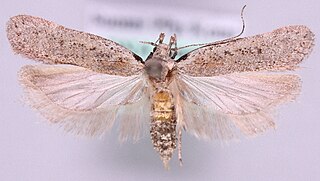
Exoteleia is a genus of moths in the family Gelechiidae.

Gelechia is a genus of moths in the family Gelechiidae. The type species is Gelechia rhombella.

The juniper gelechiid moth is a moth of the family Gelechiidae. It is known from most of Europe. It is an introduced species in Great Britain and North America through accidental introduction in garden junipers.

The sea buckthorn moth is a moth of the family Gelechiidae. It is found from Fennoscandia to the Pyrenees, Italy and Romania and from Great Britain to Ukraine.
Gelechia clandestina is a moth of the family Gelechiidae. It is found in Russia.
Chionodes holosericella is a moth of the family Gelechiidae. It is found in Norway, Sweden, Finland, Latvia, Estonia, France, Germany, Austria, Italy, Croatia, Slovakia, Ukraine and Russia. Outside of Europe, it is found in the Caucasus, from Siberia to the Magadan Oblast and in South Korea.

Gelechia rhombella, the apple groundling, is a moth of the family Gelechiidae. It is found in Europe, the Caucasus, Transcaucasia, southern Siberia, the Russian Far East, Korea and China.

Gelechia sororculella, the dark-striped groundling, is a moth of the family Gelechiidae. It is widely distributed from Europe, throughout Siberia to the Russian Far East.
Gelechia jakovlevi is a moth of the family Gelechiidae. It is found in Finland, the Baltic region, Ukraine, the European part of Russia, Siberia and Mongolia.
Gelechia basipunctella is a moth of the family Gelechiidae. It is found in from central Europe to Russia, Turkey and Mongolia.

Gelechia turpella, the grand groundling, is a moth of the family Gelechiidae. It is widely distributed in Europe. Outside of Europe, it is found from the Caucasus to Siberia and the Russian Far East. The habitat consists of woodlands and parks.

Gelechia senticetella, the cypress groundling, is a moth of the family Gelechiidae. It was described by Otto Staudinger in 1859. It is found in most of Europe, including Austria, Belgium, Bosnia and Herzegovina, Croatia, Cyprus, France, Germany, Greece, Hungary, Italy, North Macedonia, Sicily, Slovakia, Spain, Switzerland and Ukraine. It is thought to be an introduced species in Great Britain.

Gelechia scotinella, the thicket groundling, is a moth of the family Gelechiidae. It was described by Gottlieb August Wilhelm Herrich-Schäffer in 1854 and is found in almost all of Europe. The habitat consists of mature hedgerows and scrubland.

Gelechia rhombelliformis is a moth of the family Gelechiidae. It was described by Otto Staudinger in 1871. It is found from the Netherlands and Germany east to Russia and from Denmark and Latvia south to Austria, Hungary and Romania.
Gelechia cuneatella, the long-winged groundling, is a moth of the family Gelechiidae. It was described by Douglas in 1852. It is found in northern, central and eastern Europe, Russia, China and Japan. The habitat consists of river banks and marshes.

Gelechia asinella is a moth of the family Gelechiidae. It is found in France, Germany, Austria, Switzerland, Italy, the Czech Republic, Slovakia, Slovenia, Serbia, Hungary, Romania and Poland, as well as on Corsica.
Gelechia aspoecki is a moth of the family Gelechiidae. It is found in southern France.
Gelechia dujardini is a moth of the family Gelechiidae. It is found in France, Croatia, North Macedonia, Greece, Italy and Turkey.
Gelechia mediterranea is a moth of the family Gelechiidae. It is found in France, Spain and Greece, as well as on Sardinia and Crete.
Gelechia sirotina is a moth of the family Gelechiidae. It is found in Belarus, Tajikistan and the Russian Far East.










